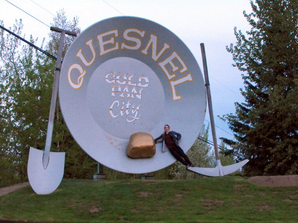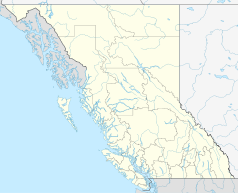Quesnel (British Columbia)
| Quesnel | ||
|---|---|---|
 Oversized gold panning pan in Quesnel |
||
| Location in British Columbia | ||
|
|
||
| State : |
|
|
| Province : | British Columbia | |
| Regional District : | Cariboo | |
| Coordinates : | 52 ° 58 ′ N , 122 ° 30 ′ W | |
| Height : | 474 m | |
| Area : | 35.38 km² | |
| Residents : | 10,007 (as of 2011) | |
| Population density : | 282.8 inhabitants / km² | |
| Time zone : | Pacific Time ( UTC − 8 ) | |
| Postal code : | V2J | |
Quesnel is a city in the Cariboo Regional District of the Canadian province of British Columbia . The parish is located at the confluence of the Quesnel River with the Fraser River . It originated on the Cariboo Road (also called Cariboo Wagon Road or Great North Road ), a section of today's Highway 97 , which connected the settlements of the gold prospectors during the Cariboo gold rush (from 1861) with the places on the southern Fraser River. It is also at the end of the Alexander MacKenzie Heritage Trail .
history
Before the town was founded, members of the Carrier First Nations ( Dakelh ) lived in the region, who recognized the advantages of the location at the confluence of the Fraser and Quesnel rivers early on.
Quesnel was initially called Quesnellemouth to distinguish it from Quesnel Forks , about 100 km up the Fraser. The name goes back to Jules-Maurice Quesnel , one of the participants in Simon Fraser's expedition . In 1808, Simon Fraser drove down the Fraser with his voyageurs to find the mouth of the Columbia River in the Pacific. Fraser sent Lieutenant Jules-Maurice Quesnel to investigate the Quesnel River , later named after him . Already around 1870 the place was called Quesnelle , around 1900 Quesnel .
William Dietz, Ned Stout and Bill Cunningham discovered small gold deposits at Williams Creek in the spring of 1861, and when Billy Barker had to dig below the creek at Blackjack Canyon because the claims had been awarded, his company seemed similarly hopeless. But in 1862 Barker & Company made extensive gold discoveries there, which triggered a gold rush. This made Quesnel an important supply post for thousands of prospectors.
Initially, the place was accessible via the First Nations trails , later via the Cariboo Wagon Road . But the settlement suffered several setbacks. A fire destroyed the city in 1863, and this was repeated in 1874. The Quesnel Volunteer Fire Department was established in 1910 , but in January 1916 the most devastating city fire in Quesnel history occurred.
An attempt to build a path along the coast escalated in 1864, with several deaths and the execution of Klatsassins in the Chilcotin War . In 1875 the first bridge spanned the Quesnel River, but it collapsed that same year.
Nevertheless, the settlement stabilized. Up until the 1940s, gold was the predominant economic factor, followed by agriculture and forestry. The first school was built in 1886 on the site of the later Helen Dixon Center . Steam ships operated here from 1862 to 1886 and again from 1909 to 1921. The first theater was built in 1914. In 1921 the Pacific Great Eastern Railway connected it to the rail network. The airport opened in 1942 and was taken over by Quesnel in 1993. The first hospital was built in 1910 and a second followed in 1920. A total of four of these facilities were created.
Today the Billy Barker Days commemorate the time of the gold diggers and the founder of Barkerville on every third weekend in July. In 2000, Quesnel hosted the British Columbia Winter Games , an amateur sports event.
The official award of local self-government for the municipality took place on March 21, 1928 ( incorporated as Village Municipality ). After the municipality reached the status of a small town ( Town Municipality ) on January 1, 1958 , it has now even received the status of a city ( City Municipality ).
Demographics
The 2011 census showed the city had a population of 10,007. The city's population has increased by 7.3% compared to the 2006 census and is thus slightly above the trend for the entire province of British Columbia, where the population also increased by 7.0%. With an average age of 41.9 years, the population here corresponds exactly to the average for the entire province.
economy
The most important industries for the labor market in Quesnel are forestry and the woodworking industry.
The median income of Quesnel employees in 2005 was an above-average C $ 25,894 , while at the same time the average for the entire province of British Columbia was C $ 24,867. The difference in income between men (C $ 43,783, national average C $ 31,598) and women (C $ 17,982, national average C $ 19,997) is above average; it can only be partially explained by the different employment levels of men and women.
traffic
In terms of traffic, the community is opened up by Highway 97, which crosses Quesnel in a north-south direction. In addition, Highway 26 branches off from Highway 97 to Barkerville on the northern edge of the community .
A railway line also crosses the village in a north-south direction. Quesnel Airport is around 6 km north of the municipality .
sons and daughters of the town
- Tim Traber (* 1993), ice hockey player
- Garrett Festerling (born 1986), ice hockey player
- Brett Festerling (* 1986), ice hockey player
Web links
supporting documents
- ^ Origin Notes and History. Quesnel. GeoBC , accessed October 23, 2013 .
- ^ Quesnel Community Profile. Census 2011. Statistics Canada , March 30, 2013, accessed October 23, 2013 .
- ↑ Quesnel Community Facts. (PDF, 48.05 kB) BCStats , accessed on October 24, 2013 (English).
